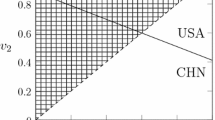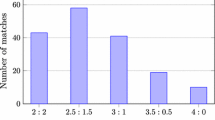Abstract
A competition which is based on the results of (partial) pairwise comparisons can be modelled by means of a directed graph. Given initial weights on the nodes in such digraph competitions, we view the measurement of the importance (i.e., the cardinal ranking) of the nodes as an allocation problem where we redistribute the initial weights on the basis of insights from cooperative game theory. After describing the resulting procedure of redistributing the initial weights, an iterative process is described that repeats this procedure: at each step the allocation obtained in the previous step determines the new input weights. Existence and uniqueness of the limit is established for arbitrary digraphs. Applications to the evaluation of, e.g., sport competitions and paired comparison experiments are discussed.
Similar content being viewed by others
References
C. Berge, Graphs and Hypergraphs, North-Holland Mathematical Library, Vol. 6 (1970).
M.A. Berger, An Introduction to Probability and Stochastic Processes (Springer, New York, 1993).
P. Borm, R. van den Brink, R. Levinsky and M. Slikker, On two new social choice correspondences, CentER Discussion Paper 2000-125, Tilburg University, Tilburg, The Netherlands (2000).
R. van den Brink and P. Borm, Digraph competitions and cooperative games, TI-Discussion Paper, Free University and Tinbergen Institute, Amsterdam, The Netherlands (1994).
R. van den Brink and R.P. Gilles, A social power index for hierarchically structured populations of economic agents, in: Imperfections and Behaviour in Economic Organizations, eds. R.P. Gilles and P.H.M. Ruys (Kluwer Academic, Dordrecht, 1994).
H.E. Daniels, Round Robin tournament scores, Biometrika 56 (1969) 295-299.
H.A. David, The Method of Paired Comparisons (Griffin, London, 1963).
R. Joosten, Dynamics, equilibria and values, Ph.D dissertation, Maastricht University, The Netherlands (1996).
J.P. Keener, The Perron-Fröbenius theorem and the ranking of football teams, SIAM Review 35 (1993) 80-93.
G. Laffond, J.F. Laslier and M. Lebreton, The bipartisan set of a tournament game, Games and Economic Behavior 5 (1993) 182-201.
J.F. Laslier, Tournament Solutions and Majority Voting (Springer, Berlin, 1997).
A. Rubinstein, Ranking the participants in a tournament, SIAM Journal of Applied Mathematics 38 (1980) 108-111.
L.S. Shapley, A value for n-person games, in: Annals of Mathematics Studies 28, eds. H.W. Kuhn and A.W. Tucker (Princeton University Press, 1953) pp. 307-317.
L.S. Shapley, Cores of convex games, International Journal of Game Theory 1 (1971) 11-26.
Author information
Authors and Affiliations
Rights and permissions
About this article
Cite this article
Borm, P., van den Brink, R. & Slikker, M. An Iterative Procedure for Evaluating Digraph Competitions. Annals of Operations Research 109, 61–75 (2002). https://doi.org/10.1023/A:1016339832755
Issue Date:
DOI: https://doi.org/10.1023/A:1016339832755




